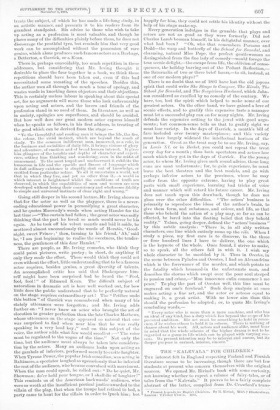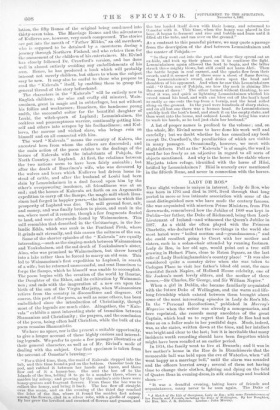THE "ICALEVALA" FOR CHILDREN.*
Tim interest felt in England respecting Finland and Finnish literature seems to be increasing, though there are but few students at present who concern themselves with the original sources. We opened Mr. Eivind's book with some curiosity, not knowing whether to expect a volume of fairy-tales, or of tales from the " Kalevala." It proves to be a fairly complete abstract of the latter, compiled from Dr. Crawford's trans- * Finnish 1,4genils for Englixh Children. By R. Eivinaz With 7 Misty:WO:is.
Loudon: 1.893.
lation, the fifty Runos of the original being condensed into thirty-seven tales. The Marriage Runos and the adventures of Kullervo are, however, very much compressed. The stories ere pot into the month of "Father Nikko," an old merchant, who is supposed to be detained by a snowstorm during a journey through Northern Finland, and who relates them for the amusement of the children of his entertainers. Mr. Eivind has closely followed Dr. Crawford's version, and has done well in almost entirely avoiding any embellishments of his own. Hence, he has produced a book which will probably interest not merely children, but others to whom the subject may be new. It may also be useful to those who propose to read the "Kalevala " itself, by enabling them to grasp the general thread of the story beforehand. The characters in the "Kalevala" will be entirely new to English children ; the wise and crafty old minstrel, Wain- amoinen, great in magic and in subterfuges, but not without his follies and weaknesses ; llmarinen, the handsome young smith, the successful suitor for the beautiful daughter of Louhi, the witch-queen of Lapland ; Lemminkainen, the reckless and presumptuous warrior, continually getting him- self and others into scrapes by his foolhardiness ; and Kul- lervo, the morose and wicked slave, who brings ruin on himself and on all connected with him. The word " Kalevala " means the country of Kaleva, the ancestral hero from whom the others are descended ; and the main action of the poem relates to the dealings of the heroes of Kalevala, with the inhabitants of Pohjola, the North Country, or Lapland. At first, the relations between the two nations seem to have been fairly amicable ; but after the death of Ilmarineu's wife, who was devoured by the wolves and bears which Kullervo had driven home in- stead of cattle, and after the husband of Louhi had been slain by Lemminkainen in a duel forced upon him by the other's overpowering insolence, all friendliness was at an end ; and the heroes of Kalevala set forth on an Argonautic expedition to carry off the Sampo, the magic mill which Ilma- rinen had forged in happier years,—the talisman to which the prosperity of Lapland was due. The mill ground flour, salt, and money, and was finally broken to pieces, and sunk in the sea, where most of it remains, though a few fragments floated to land, and were afterwards found by Wainamoinen. This mill resembles that described in the GrOttasiingr, in the Ice- landic Edda, which was sunk in the Pentland Firth, where it grinds salt eternally, and this causes the saltness of the sea. Some of the shorter episodes of the " Kalevala" are equally interesting,—such as the singing-match between Wainamoinen and Youkahainen, and the sad death of Youkahainen's sister, Aino, who was promised to Wainamoinen, but threw herself into a lake rather than be forced to marry an old man. This led to Wainamoinen's first expedition to Lapland, in search of a wife ; but he returned unsuccessful, and sent Ilmarinen to forge the Sampo, which he himself was unable to accomplish. The poem begins with the creation of the world by Ilmatar, the Daughter of the Ether, and its cultivation by Wainamoi- nen; and ends with the inaguration of a new era upon the birth of the son of the Virgin Marjatta, when Wainamoinen retires from the country in discomfitUre and disgrace. Of course, this part of the poem, as well as some others, has been embellished since the introduction of Christianity, though most of the legends are much older. Altogether, the " Kale- vela " exhibits a most interesting state of transition between Shamanism and Christianity ; the prayers, and the conclusion of the poem, being often half Christian, while the bulk of the poem remains Shamanistic. We have no space, nor is the present a suitable opportunity, to give a longer account of these highly curious and interest- ing legends. We prefer to quote a. few passages illustrative of their general character, as well as of Mr. Eivind's mode of dealing with the subject. Our first specimen is taken from the account of Osmotar's brewing:— " For a third time, then, the maid of Kalevala stepped into the tub, and this time found a pod on the bottom. Osmotar took the pod, and rubbed it between her hands and knees, and there flew out of it a honey-beo. She sent the bee off to the Islands of the Sea, telling it to go to a meadow there, whore a maiden lay asleep ; and growing by the maiden's side there were honey-grasses and fragrant flowers. From these the bee was to collect the honey, and bring it back. The bee flew off straight over the ocean, and on the evening of the third day reached the Isles of the Sea, where it found the maiden fast asleep among the flowers, clad in a silver robe, with a girdle of copper. • A Sketch of the Life of Georyiana, Lady de Roe ; with smite Remiaineeyeee of
the bee loaded itself down with their honey, and returned to Osmotar with it. This time, when the honey was placed in the beer, it began to ferment and rise and bubble and foam until it filled all the tubs, and ran over on the ground."
As a contrast to this peaceful picture, we may quote a passage from the description of the duel between Lemminkainen and the master of Pohjola :— " So they went out into the yard, and there they spread out an ox-hide, and took up their places on it to continue the fight. Lemminkainen again allowed the host to begin, and the latter struck three mighty blows, but still could not harm Ahti. Then the battle began in real earnest, and the sparks flow from their swords until it seemed as if thero were a sheet of flame flowing from Lemminkainen's sword, and down upon the head and shoulders of his opponent. And when he saw this Lemminkainen said : 0 thou son of Pohjola, see how thy neck is shining like the ocean at dawn ' The other turned without thinking, to see what it was, and quick as lightning Lemminkainen whirled his sword round his head, and with one blow cut off the host's head as easily us one cuts the top from a turnip, and the head rolled along on the ground. In the yard were hundreds of sharp stakes, and on all but one there was a human head. So Lemminkainen quickly took the host's head, and stuck it on the empty stake, and then went into the house, and ordered Louhi to bring him water to wash his hands, as he had just slain her husband."
A list of proper names is prefixed to the volume ; and, on the whole, Mr. Eivind seems to have done his work well and carefully ; but we doubt whether he has consulted any book except Dr. Crawford's, the peculiarities of which are visible in many passages. Occasionally, however, we meet with slight defects. Full as the " Kalevala" is of magic, the word is used far too freely as an adjective in regard to all sorts of objects mentioned. And why is the horse in the stable where Marjatta takes refuge, identified with the horse of Hiisi, bridled by Lemminkainen P Hiisi is scarcely ever mentioned in the fiftieth Runo, and never in connection with the horses.





















































 Previous page
Previous page